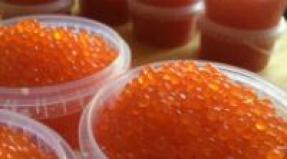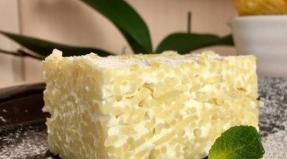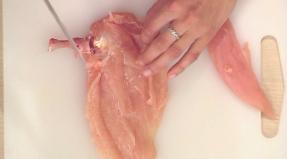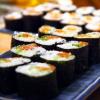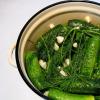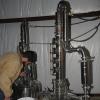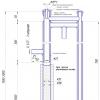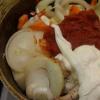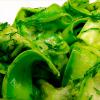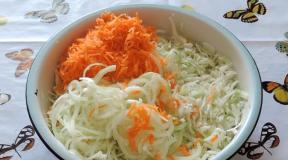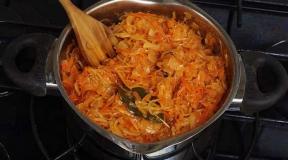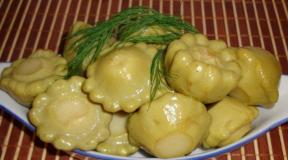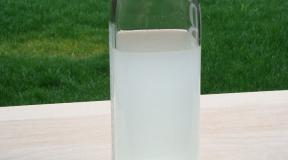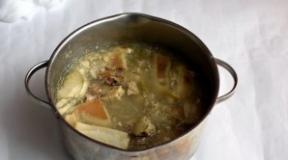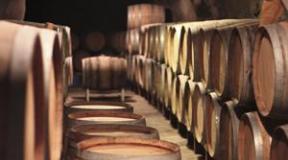Replacement of vinegar essence with citric acid. How to replace wine vinegar in a salad, recipe, marinade and baked goods, the best analogues
Summer is a time when every housewife tries to hide as many tasty fruits as possible in jars, which on a frosty winter day will remind of the sun, lush greenery of trees and herbs. Before canning, it is not only the choice of the most delicious recipes that worries, but also the question of how the blanks will be preserved. Torn off lids, spoiled contents, incomprehensible unappetizing sediment in cans - all this will not add to the mood on the New Year holidays.
Most often, such a nuisance happens not due to improper preservation processes, but for reasons associated with one of the components - vinegar. The choice of this ingredient is responsible and complex, low-quality vinegar is able to cancel out all the efforts of the hostess in a very short time.
Table vinegar
The most popular component for making homemade products.
You should know that it is ordinary table vinegar that will remarkably preserve preservation for a long time, improving the taste and adding a little amazing sourness.
Table (9% vinegar) is obtained by diluting the vinegar essence (acid) in the proportions necessary for this. Manufacturers offer a ready-made product, but you can carry out such a simple process yourself, adhering to the recommended proportions.
When buying table vinegar, pay attention to the label: the acid concentration may be weaker, which is not suitable for canning.
A prerequisite is 9%, unless the recipe requires a different ratio of acid and water percentages.

Table vinegar can be alcoholic. This type is preferable to use for the preparation of blanks. The taste of preservation improves (it becomes softer, vegetables acquire a delightful aroma and piquant notes), the contents are stored much longer, and cans rarely explode.
Natural vinegar
Natural types of vinegar are obtained from apples, grapes, and other fruits that contain essential acids. The label of such a product certainly contains information that allows you to find out what exactly is contained in the container.
If "Natural" or "Biochemical" is indicated, you can safely purchase the product without fear for the health of loved ones.
Natural vinegar often says it contains several ingredients. This means that juices from different fruits were used in the preparation of the product, which not only does not spoil the taste during canning, but also adds new flavors.

A small amount of cloudy sediment at the bottom of the container with vinegar should not be alarming: this is inevitable, because the product is completely natural. Such a product cannot contain more than 9% acid, if when buying fruit vinegar the label says otherwise, it is better to refrain from purchasing dubious liquid, this can be not only fatal to the contents of the cans, but also harm health.
Apple vinegar
Already from the name itself, you can find out that it is made from apples. Such a product is very useful for health, it is used for cooking various dishes or even in cosmetology.
For all its advantages, apple cider vinegar is not recommended for canning.
Numerous reviews indicate that blanks are stored for a short time.

If the preservation recipe requires the addition of apple cider vinegar, it is better to prepare a small amount of salad or marinades so that they can be consumed in a short time. The short shelf life is compensated by the amazing taste, canned tomatoes or peppers acquire a new vinegar-fruity aroma, which will dissipate throughout the apartment in no time.
Vinegar essence
The main thing that you need to know about such a product is that the concentration of vinegar in it is very high - up to 70%. What does it mean? Use the vinegar essence with extreme caution; the marinade can acquire an unpleasant metallic taste or an oily sheen. This happens for one reason: this product is not manufactured for conservation, it is used for technical purposes.

In order not to spoil the taste or appearance of canned cucumbers, when buying, it is better to ask about the quality of the product, purpose, concentration.
If recipes require just table vinegar, you do not need amateur performance, it should be diluted in the following proportions:
- 1 spoon of essence in 7 tablespoons of water (vinegar 9%);
- 1 liter of essence for 8 liters of water (8% vinegar);
- 1 liter of essence for 9 liters of water (7% vinegar);
- 1 liter of essence for 11 liters of water (6% vinegar).
Adhere to the proportions strictly, because it is the concentration that determines the shelf life of conservation and the quality of the finished product.
Vinegar is a useful product for the body, but it can quickly and irrevocably spoil tooth enamel. To prevent this from happening, after dinner with homemade canned food, you should brush your teeth, or at least thoroughly rinse it several times.
You should not abuse canning with a lot of vinegar, even if you have your favorite peppers with vegetables for lunch.
In some cases, this supplement can stimulate liver or stomach diseases. If there are already family members in the house with these problems, you can try replacing the vinegar with other ingredients.
Using citric acid to prepare the marinade will hardly change the taste of the preservation.

The ratio of citric acid to water to replace vinegar:
- 9% vinegar - acids 1 tsp. at 14 st. l. water;
- 6% vinegar - 1 tsp acids at 22 tbsp. l. water;
- 5% vinegar - 1 tsp acid at 26 tbsp. l. water.
Be sure to take boiled, chilled water. After preparing the acidic solution, you can take up the marinade. Sugar and salt are usually added as needed according to the recipe: citric acid does not require an increase in the weight of the components.
It's important to know
- It is imperative to remember that the shelf life of vinegar essence or simple natural vinegar is different. While the acid will not lose its properties for more than ten years, a natural product should only be used for a few years. After this period, the beneficial properties disappear, even if the vinegar looks quite suitable for use.
- It is not recommended to use the essence in canned mustard recipes. Such a mixture can spoil the workpiece even before it is sent to storage. Instead, choose a different recipe or use plain vinegar.
- Acetic acid - residues from the production of fertilizers from natural gas or sawdust. Before using the product in blanks, you need to think several times whether preservation with such an ingredient will be useful. Even if the contents of glass containers are stored for several years, you should not risk your health when serving your favorite pickled vegetables.
- If you can't do without the preparation of acetic acid, you need to store it out of the reach of small children. Such a concentrated product can cause a painful widespread burn in a child if it comes into contact with the skin, and if it gets inside the body, it can be fatal.
- Working with acid requires special attention and care. In case of contact with the skin, immediately wash the injured area with cold water, if the damage is serious, consult a doctor immediately.
Acetic acid is banned in many countries as a product for use in kitchens. Our counters are replete with harmful products produced specifically for large industries. Before purchasing the essence, you need to decide whether it is worth risking your health.
Acetic essence is a solution of 20% water and 80% concentrated acetic acid. In terms of organoleptic characteristics, it is a colorless liquid with a pungent specific odor and sour taste.
Food vinegar essence is obtained not by combining acid with water, but by distilling 5% vinegar, which naturally forms when wine is sour. Pure acid can only be removed chemically by acting on acetates with sulfuric acid.
Curious! 100% acetic acid is called glacial, because when cooled to 17 ° C, it turns into ice-like crystals.
In home cooking, we are often faced not with the essence itself, but with its aqueous solution from 3 to 13%, known as table vinegar. However, for the preparation of some marinades and canned products, it is precisely a 70% acid solution that is required. What to do if it was not at hand? Is it possible and if so, how to replace vinegar essence with 9% vinegar?
Interchangeability of essence and vinegar
In fact, these 2 fluids are completely interchangeable, since they are made from the same raw materials and differ only in concentration.
For example, 9% vinegar consists of 1 part essence and 7 parts water. Those. 8 tablespoons of 9% vinegar contains 1 spoon of essence and 7 water. Their ratio is 1 to 7.

Knowing the correct ratio of essence and water in table vinegar of a certain concentration, you can easily calculate the required amount of components mixed to obtain it:
- 3% - 1 ml of essence and 20 ml of liquid (1:20);
- 4% - 1 ml of acid and 17 ml of water (1:17);
- 5% - 1 ml of vinegar essence and 13 ml of liquid (1:13);
- 6% - 1 ml of food acid and 11 ml of water (1:11);
- 9% - 1 ml of essence and 7 ml of liquid (1: 7).

Important! Vinegar essence can be dangerous in its pure form. Only 20 ml of the product is a lethal dose for humans, so strictly observe the proportions and caution when handling it..
How to replace the essence with ordinary vinegar
You can make calculations in the opposite direction to find out how much vinegar you need to take instead of 70% food essence. But since there is more water in a diluted solution than in a concentrated solution, you will have to add less liquid to the brine.
Consider 9% vinegar as an example. It consists of 8 parts, 1 of which is acid and 7 of which is water. Therefore, to replace 1 tsp. take essences 8 tsp. vinegar and subtract 7 tsp from the liquid specified in the recipe.
Or like this: 100 ml of essence = 800 mg 9 vinegar, in which 100 mg is acid, and 700 is water.

With the help of such simple mathematical calculations, you can draw up a pattern according to which 1 tsp essences are:
- 21 tsp vinegar 3%, minus 20 tsp. marinade water;
- 18 tsp 4% solution and take away 17 tsp. liquids;
- 14 tsp vinegar 5%, minus 13 tsp. water;
- 12 tsp 6% solution, subtract 11 tsp. liquids;
- 8 tsp vinegar 9% and minus 7 tsp. water.
On a note! One tablespoon contains 15 ml of vinegar. In the tea room - 5 ml.
Calculation example:
Suppose, according to the recipe, you need to pour 20 g of vinegar essence into the brine. How much 9% vinegar do you need?
- To make it easier to calculate, you can use the general formula:
(V1 * 70%) / 9% = V2 , where V1- the volume of the essence, and V2- the amount of vinegar. - We get: V2= 20 * 70% / 9% = 155.5 ml.
- Plus, don't forget that this 160 ml consists of 20 ml of essence and 140 ml of water, because their ratio is 1: 7. This means that 140 ml less liquid should be added to the dish.
Curious! On the labels of industrial products, vinegar essence is designated as a food additive - E260.
How else to get an equivalent replacement essence
Instead of the usual vinegar, dry citric acid can also be added to marinades during canning. It is a concentrated dry product in crystals, widely used in cooking for canning and preparing drinks.

Depending on how you dilute it, citric acid can replace vinegar of one concentration or another.
One teaspoon of citric acid will require:
- 9% - 14 st. l. water.
- 6% - 22 st. l. liquids.
- 5% - 29 st. l. water.
- 4% - 34 st. l. liquids.
- 3% - at 46 st. l. water.
And if you dilute 1 tbsp. l. citric acid with two tbsp. l. water, you get a good substitute for 70% vinegar essence!
Only vinegar. Citric acid is definitely no less harmful, and I don't like the taste with it
alcohol
Citric acid
Cucumbers with citric acid instead of vinegar reviews
tablespoon = 18 g of water, 1.5 tbsp. l. = 27 g 27 * 0.7 = 18.9 g of glacial acetic acid, if we neglect the insignificant density and the difference in volume and weight percent. If we neglect the fact that citric acid is weaker than vinegar in terms of both the dissociation constant and molar weight, then gram 19-20 lemon - and you still don't have scales with a division price of 0.01-0.1 g at home. As they say on the Internet: "1 tablespoon of citric acid in crystals - 12/16 g." Therefore, without bothering, the same, 1.5 tbsp. l. , only without a slide - you still have nothing to dose with.
it is better not to replace the acid gives just acid and the essence kills the fermentation process and botulism gives spice to cucumbers and tomatoes, add 1 teaspoon of the essence to 1 liter jar directly into the jar under the lid before rolling the lid onto a 2 liter jar 1 dessert spoon, 3 -x l jar 1 tablespoon
Is it possible to use citric acid instead of vinegar in the preservation of cucumbers
I use citric acid - everyone can do it (as the doctor told me). I soak cucumbers in water for 3-4 hours (if there is no time, then you can not soak). I sterilize the jars on a kettle (I put them on the stove, plug the spout and put on the jar instead of the lid for 5 minutes), boil the lids for 20 minutes. I cut off the tips of the cucumbers. At the bottom of a 3-liter jar I put 1 umbrella of dill, 2 bay leaves, 3 black peppercorns, 1 chopped clove of garlic and 6 pieces (3-5 cm long) horseradish stalks (not the root, but a place from the root to the leaf panel, a stalk sheet). I fill the jar with cucumbers. I put the same on top. I fill it with boiling water. Let it stand for 5 minutes. I pour it into a saucepan (you can drain all the cans into one pan). I put 3 tablespoons of salt in this saucepan (calculated for 1 3-liter jar), 1 dessert spoon (or an incomplete tablespoon) of sugar, wait until it boils, and put citric acid (1 teaspoon). I pour the boiling brine into the jar and immediately roll it up. Then I wrap the jars for 3-4 hours (or overnight). Cucumbers are lightly salted, very crispy and odorous. Can be used for baby food.
Sterilize the jar, rinse the cucumbers, cut the tails, put in jars, pour boiling water for 20 minutes, drain, pour tomato juice boiled with spices, twist, turn the jar, cover and keep warm for 4-6 hours. Do not forget about the garlic, put it with cucumbers.
put cucumbers in jars, garlic, dill, horseradish leaf 3 cherry leaves (for a 3 liter jar) 3 leaves of black currant (Siberian), make a brine: 2 tablespoons of salt per liter of water, fill in and set for three days open to sour , on the third day we drain the brine, boil it and fill it, roll it up. p. from. on the second day after laying, you can eat lightly salted cucumbers, very tasty.
Pickled cucumbers with citric acid instead of vinegar
if you really want cucumbers, then make lightly salted - without preservation and without vinegar - dill seeds and bay leaf of salt from spices 2 tablespoons per liter of water
so, in general, you can only have a light broth and not a fat one
Recipes may contain ingredients that are not always available at home, but that does not mean that there is no substitute for wine vinegar in your kitchen cabinet. The site is a site for that and exists to search, find and offer you analogues, because many substances have "doublers", similar in properties and principle of action. Replacing wine vinegar in a recipe with a different product will not in any way affect the taste of the finished dish, or maybe even improve it and bring some zest.
On the basis of wine vinegar, various marinades are prepared, both for meat and for dressing salads and preservation. The range of applications for this product is much wider, because it can be used to treat cuts, eliminate the effects of bruises, whiten skin and disinfect dishes. Also, this substance can be found in homemade cosmetics.
If this product does not end on time, but it is needed for a salad or other dish, then it can be replaced with any vinegar that was created from natural ingredients. Apple apple is most suitable for these purposes, only here you need to consider the following.
In a grape vinegar product, the acid content is 9%, and in all others it varies between 3-9%. If in your kitchen you find the coveted bottle of apple cider vinegar, then pay attention to the label. If the product is of natural origin, then the acid concentration in its composition will be 3-5%, but if it was created artificially, then the acid content will be 9%. That is, substitution with a synthetic product implies a 1: 1 ratio. And if the concentration is weak, for example, 6%, then increase the dose of the substitute by 1/3.
What is a substitute for white or red wine vinegar?
Acetic acid is a component that is part of any acetic product, therefore, wine white and red are interchangeable products, and even a great gourmet cannot distinguish them from each other in a salad. If it is of principle for the cook to add an ingredient of a specific color to the dish (although they do not differ much in taste and properties), then he can replace it with ordinary grape juice, the amount of which should be 3 times more.
Sometimes these components are replaced with grape juice diluted with white wine in a 1: 1 ratio. Also, balsamic, apple, sherry, rice or any other vinegar of natural origin can act as a substitute.
How to replace wine vinegar with regular table vinegar?
Culinary experts claim that table vinegar is the worst substitute for wine. But when the hostess finds herself in a hopeless situation and there are no other alternatives in the form of citric acid, dime and dry wine, then you have to use it. The most inconvenient replacement option is vinegar essence, the concentration of which is 70-80%. To get the required product from the essence, you must take into account that 1 tsp. essences = 8 tsp table vinegar, concentration 9%. Thus, to obtain a three percent solution, it is necessary to 1 tsp. essences add 22 tsp of water.
If you need six percent, then 11 tsp water is added, and for nine percent - 7 tsp. water. The resulting solution, replacing wine vinegar, is added in the same amount, although concentration is critical here, and it can be easily determined independently.
Is it possible to substitute balsamic vinegar for wine?
It is possible, the only problem is that the cost of a real balsamic vinegar product is 100 euros for a 30 ml bottle, therefore, this is not the cheapest analogue. This price is due to the complexity of the technological process, because the product must reach the condition in oak barrels for at least 12 years.
Attention! It is economically impractical to use balsamic vinegar instead of wine vinegar, especially since it is too sharp, and if the proportions are not observed, they can ruin the dish.
Replacing wine vinegar
In the salad
- Lemon acid. This is an alternative for all occasions. If you need to replace the 9% wine vinegar product, then 1 tsp. citric acid is diluted with 14 tbsp. l of water; for a six percent water option, 22 tbsp will be required. l.
- Grape juice. Its amount is increased by 3 times, and to enhance the taste, seasonings must be added to the grape juice.
- Dry wine. It will be much better if diluted with grape juice in a 1: 1 ratio.
- Any vinegar of natural origin. The product obtained from vinegar essence according to the recipe indicated above can be used only in a desperate situation.
- Freshly squeezed lemon juice that can be diluted with either grape juice or white or red wine.
In recipes
If we are talking about culinary recipes, then grape vinegar is replaced by any other, as well as lime or regular lemon juice, grape juice, white or red wine. If we are talking about cosmetic recipes, then there is only one replacement for this product. And this is apple cider vinegar, because it is most similar in composition and properties, but subject to its naturalness.
In the marinade
It is appropriate to marinate expensive varieties of fish or meat in balsamic, the only problem is that this product is available only to a select few. Therefore, grape vinegar for the marinade is easily and inexpensively replaced with other varieties, in a 1: 1 ratio (provided that the concentrations are the same, and if they are different, then a recalculation is done). When canning, vinegar essence is most often used, which is diluted to the required concentration. If you doubt the relevance of the information provided, then you can use the table that is presented on each bottle of essence. It is noteworthy that any vinegar is easily replaced with citric acid.
In baking
What is the function of this component in baked goods? It extinguishes the soda and thereby helps to loosen the dough. Its taste and aroma properties practically do not affect the taste and smell of pies, cakes and cookies, which is explained by the low concentration of the product in the total mass.
As a substitute, you can choose any other vinegar product, lemon juice or acid diluted with water (1 teaspoon for 14 tablespoons of water), and some go in a simpler way - they buy a ready-made baking powder.
We have considered a sufficient number of options for replacing wine (grape) vinegar with analogues.
Let's talk about those acids that we most often use in food, for canning or for acidifying foods.
Many people have problems how to dilute vinegar in the right proportion, because vinegar essence contains 70% acid, and recipes require 9% or even 5% vinegar solution.
And we will also tell you how to replace the usual vinegar with apple cider vinegar or lemon juice?
How to dilute vinegar essence? (to get vinegar)
How to dilute vinegar from 70% vinegar essence:
9% vinegar, you need to take one part of the essence and add seven parts of water (1 tablespoon of the essence and 7 tablespoons of water)
6% vinegar- add 11 parts of water to one part of the essence (1 tablespoon of the essence and 11 tablespoons of water)
5% vinegar- add 13 parts of water to one part of the essence (1 tablespoon of the essence and 13 tablespoons of water)
4% vinegar- add 17 parts of water to one part of the essence (1 tablespoon of the essence and 17 tablespoons of water)
3% vinegar- add 23 parts of water to one part of the essence (1 tablespoon of essence and 23 tablespoons of water)
So, if you need 1 tablespoon of 70% vinegar essence, but you only have 5% vinegar, and its concentration is 13 times less, then you need to add 13 tablespoons of 5% vinegar.
Another point that needs to be taken into account - if the recipe says 1 tablespoon of 70% vinegar essence, and you replace the essence with vinegar in the right proportion, then you take not 1 liter of water, but several tablespoons less. That is 5% vinegar 7 tablespoons and MINUS 13 tablespoons of water.
If you need to add 1 tablespoon of 70% vinegar essence, and you only have 9% vinegar, then you need to add 7 tablespoons of 9% vinegar.
Table vinegar (9%) can be replaced with apple cider vinegar.
But you need to understand that apple cider vinegar is sold at 5%, that is, to use it instead of 9% vinegar, you need 2 times more apple cider vinegar. Instead of 1 tablespoon of 9% vinegar, we take 2 tablespoons of apple cider.
Apple cider vinegar, grape (wine), rice vinegar, balsamic vinegar and others are most often used NOT for canning, but for dishes (borsch, salads, dressings) or marinating meat and fish. Since they still have their own specific taste, introduce them into the diet of your family carefully, because as you know, we are often conservative in our tastes, especially children.
All the more careful you need to be if someone from the family has gastritis, ulcers or colitis, as well as
How to use citric acid for canning.
Most often, in recipes, you can find 2 tablespoons of bottled lemon juice or 1/2 teaspoon of lemon powder in 1 liter of water or ready-made canned food in a liter can. For a half-liter jar (for example, tomato juice ) you will need 1 tablespoon of lemon juice from a bottle or 1/4 teaspoon of dry lemon powder.
Please note that bottled lemon juice and freshly squeezed lemon juice are not the same thing. And for salad dressing, instead of one tablespoon of 6% vinegar, you need two tablespoons of freshly squeezed lemon juice.
How to dilute dry citric acid?
If we need to dilute citric acid instead of vinegar, which is written in the recipe, then use our memo. We have indicated the percentage of vinegar and the amount of citric acid (dry).
Dilute citric acid crystals with water in the following proportion:
- 1 tablespoon dry citric acid on 2 tablespoons of water ... You will succeed substitute for 70% vinegar essence ... (i.e. you need to take as much lemon solution as the vinegar essence is indicated in the recipe - 1 teaspoon, for example)
- 1 teaspoon dry citric acid on 14 tablespoons of water ... You will succeed substitute 9% vinegar .
- 1 teaspoon of dry citric acid to 22 tablespoons of water. You will have a 6% vinegar substitute.
- 1 teaspoon of dry citric acid to 26 tablespoons of water. You will have a 5% vinegar substitute.
- 1 teaspoon of dry citric acid to 34 tablespoons of water. You will have a substitute for 4% vinegar.
- 1 teaspoon of dry citric acid to 46 tablespoons of water. You will have a substitute for 3% vinegar.
Food additive E330 is citric acid, produced in accordance with GOST 53040-2008 (old GOST 3652-69). By the way, citric acid is safe for the human body and does not irritate the mucous membranes of the respiratory and digestive tract.

